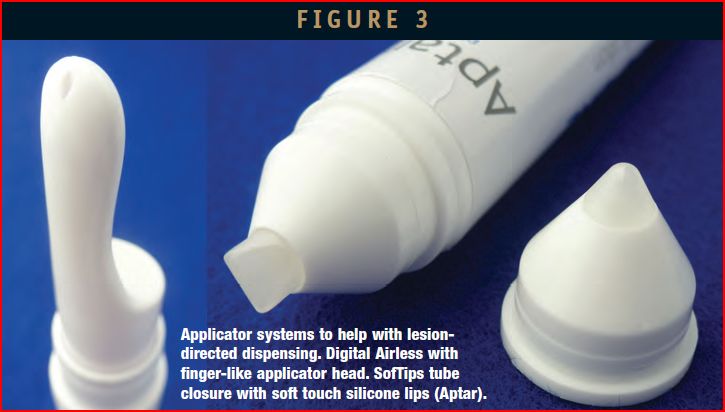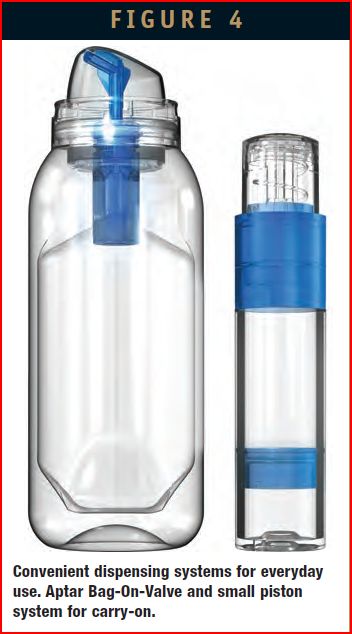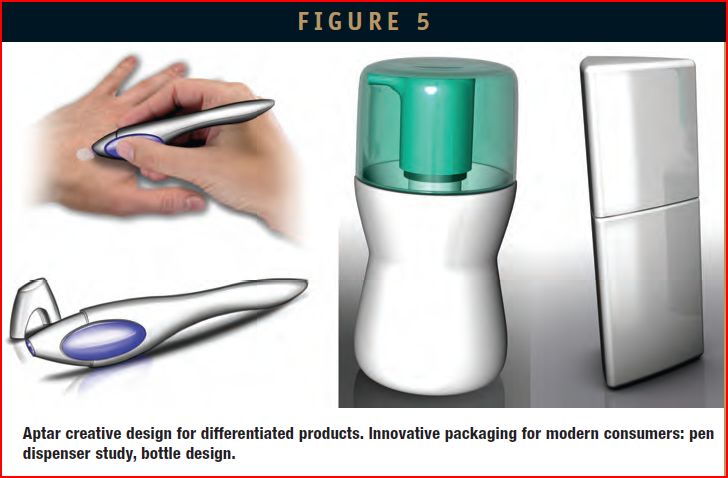Issue:September 2013
TOPICAL TRENDS - Trends in Skin Medication Dispensing
INTRODUCTION
Skin diseases are among the most common diseases worldwide. Approximately one third of the population is affected with a pathological skin problem during their lifetime. In 2010, the total dermatology drug market has been valued at $26.8 billion and is estimated to grow at a CAGR of 3.7% until 2015. This growth will slow down during subsequent years reaching an estimate volume of $37.8 billion in 2026.1
Up to 25% of total healthcare spending is for dermatology conditions. So dermatology is certainly not a niche market. Within the five largest European Union countries (EU5) almost 70% of skin medications are prescription-only drugs. This split is considered to reverse throughout the next years in favor to over-the-counter (OTC) products due to the following observations:
• The number of new drug molecule entries into the dermatology market is not projected to increase.2
• Price regulation and pressure will lead to increasing numbers of switches from prescription to OTC availability of medication. The OTC market still allows for more freedom in price positioning.
• As most skin diseases are not life-threatening and often considered a “nuisance” rather than a disease, many patients do not seek physicians’ help.
In addition to the well-documented use of medicated drugs, there is a large market of non-medicated skin care products: emollients, skin cleansers, or hydration and protection products, among others. The following focuses on trends in topical skin medication, the impact on primary packaging, and possible dispensing solutions.
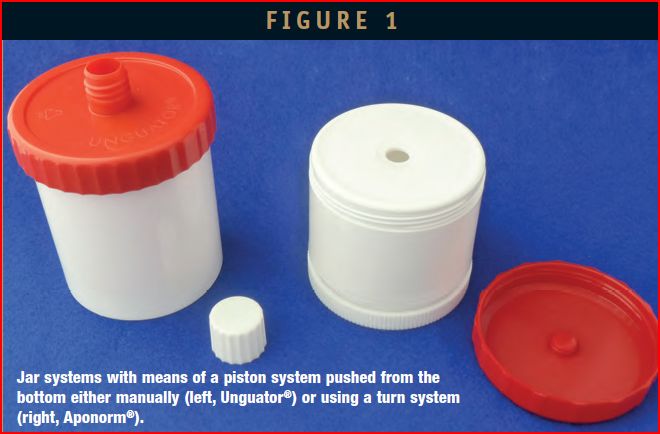
CURRENT PACKAGING FOR SKIN MEDICATION
In 2011, almost 500 million units of topical skin medication have been sold within the EU5 countries. More than 90% of these products have been of semi-solid formulations, such as lotions, creams, ointments, gels, pastes, or foams. The remaining share has been evenly split into liquids and powders.3
Tubes are well established and often the first choice for most semi-solid drugs. The simplest and cheapest version is the single layer plastic tube. But barrier function (light, evaporation) is somehow limited. Increased barrier function requirements can be satisfied by use of aluminum or multilayer tubes. The latter combine the barrier function of an aluminum layer with the look-and-feel of a tube. Tubes can be combined with a wide range of closures with different design and functionality. When a tube is opened, its content is exposed to environmental influences; drying and discoloration can occur. Also, dosing and emptying is greatly dependent upon tube type and user experience. Notably, aluminum tubes are prone to breakage and leakage if not properly handled.
The use of jars in topical dermatology is easily explained by the need for easy access to the final product. Pharmacy-made formulations and reconstituted medications often require a large opening. In turn, this also means a large surface in contact with oxygen and allowing for evaporation. Some systems try to limit environmental influences. Additionally, attempts have been made to have better control while dispensing product (rere 1).
Liquids and low-viscous products are often filled into bottles. While colored glass bottles offer the best barrier functions (evaporation, light protection), plastic bottles are often preferred because of the lower risk of breaking. In order to increase barrier functions, special plastic bottles incorporate a co-blow-molded multilayer bag inside. Basic screw and flip-top closures are very common in combination with bottles but bear the risk of drying and discoloration of product around the orifice. The high-end version of a bottle closure is the pump dispenser, which helps deliver a consistent dose of product with each actuation.
Other primary packaging types used in skin medication include pouches, sachets, or stick packs for single doses, airless dispensing systems, or aerosols, including bag-on-valve (BOV) systems for multiple uses. In addition to these standard dispensing systems, a range of specialized and often customized packaging solutions has been created. Some trends in the topical dermatological market begin to change the way these drugs are presented to the end consumer. Trends that drive this change and, therefore, are important to the pharmaceutical industry include: • changes in life-style and demographics • increased awareness of drug safety • pressure to deliver cost-efficient treatments • drying pipelines of drug innovation • pressure to differentiate existing products from competition In addition to these general challenges, skin medication requires a special focus on protection of mostly semi-solid drug products, convenient dosing, access to difficult-to-reach body areas, and lesiondirected treatment.
PROTECTION FROM ENVIRONMENTAL INFLUENCES
It is likely that innovative drug formulations will demand increased protection through primary packaging. Shelf storage for up to 3 years is followed by an in-life period of a few weeks. Following first dispensing, remaining product on the dispensing system tends to dry or potentially crystallize. This is particularly observed with viscous formulations in which drying product can lead to clogging and subsequent malfunction of the dispensing system.
Topical dermatology products often use fatty or oily auxiliary components to enhance the retention on and uptake of the drug substance through the skin. Such formulations are often sensitive to a variety of environmental influences. Exposure to sunlight or oxygen can lead to deterioration of drug substance activity as well as development of unfavorable color.
Intake of moisture from the environment into the formulation or evaporation of water or solvents from the package will potentially lead to deterioration of content. Consequently, diffusion has to be eliminated by use of appropriate packaging material providing sufficient barrier function.
During the in-use period, the orifice of any dispensing system is the most challenging region. Clogging due to drying product is actually the most often reported complaint. Standard pump systems represent a constant barrier to outside air in itself. However, at the outer part of the dispenser, they will not avoid oxygen exposure or clogging due to evaporation. Therefore, modern pump dispensing systems are designed in such a way that the orifice is closed between the actuations. This prevents entry of air into and drying of the medication within the system. Different technical options are available on the market. Flexible closing lips support clean dispensing and help protect against air intake during periods of storage. Selfclosing mechanisms can be designed into pump actuators to better protect dispensing orifices (Figure 2).
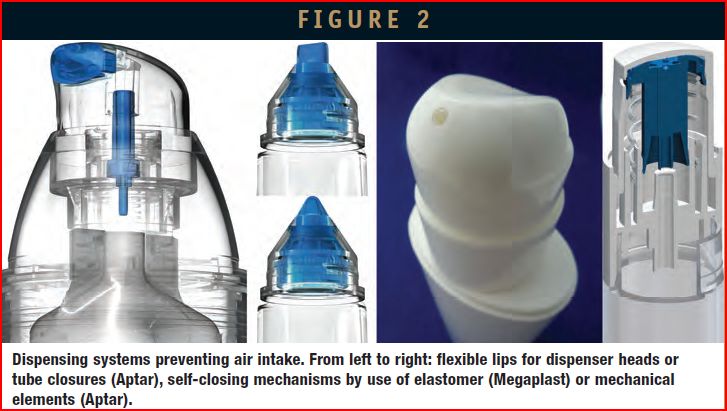
If product is dispensed from a vented system, ambient air will replace the dosed volume in the container and consequently get in contact with the remaining product. This may be critical for oxygen-sensitive drug products. In such situations, so-called unvented or airless packaging systems should be used. In these airless systems, moving parts (tow piston) or collapsing bags compensate for the volume of the dispensed product. In such systems, the wall of the container must be able to barrier against oxygen diffusion. Alternative systems use a plastic or aluminum bottle to provide the desired outer shape and use aluminum or multilayer inner bags to contain the product.
PROTECTION FROM MICROBIAL CONTAMINATION
To keep microorganism levels in the product low during the in-use period, most often, preservatives are used. Especially in patients with diseased skin, preservatives are a potential source of additional irritation. For example, parabens (ie, parahydrobenzoic acid esters) have come under scrutiny after observation of contact sensitization exacerbating in patients with inflamed or broken skin. Even if paraben levels nowadays are below limits where they are generally recognized as safe, they have been eliminated from most skin medications. However, the use of other preservatives that serve as replacement bears the same concerns about irritation. Therefore, an increasing amount of preservative-free formulations are entering the skin medication market.
Primary packaging and dispensing systems that are able to handle nonpreserved drug products need to prevent bacterial ingress into the drug product. These dispensing systems build a physical barrier to microbes at the interface to the outside. Sealing needs to be sufficiently strong to break product micro-films. Modern systems make use of elastomer elements or spring-loaded tips sealing the dispensing orifice. They can effectively protect non-preserved formulations or allow for lower concentrations thereof.
Another source of microbes is venting air. Whereas non-vented packaging prevents contamination by avoiding incoming air, sophisticated systems allow incoming air to pass through layers of filtering micromembranes.
CONSUMER CONVENIENCE
A substantial number of dermatological diseases require daily use of skin medication. Therefore, dispensing systems should be convenient, supporting patients’ adherence to long-time treatment. Smooth actuation and good control of product flow can be obtained from nonmetered systems (eg, BOV, tube). But obtaining a consistent amount of medication as appropriate for the diseased skin area is difficult and very much user dependent. Precise dosing recommendations are not easily provided. Commonly, these are either describing the thickness of product layer onto the affected area (eg, “Cover … with a thin film of…”), make use of comparisons to phalanges, or provide card box rulers together with the medication package.
Metered dispensing systems for lotions or creams are available using precision pumps. Delivering a consistent dose per stroke from a metered pump system enables the patient to have the same amount of product used each day. Thus the prescribed dose is ensured, and safety concerns regarding overdosing are minimized.
PRODUCT DISPENSING & APPLICATION
In dermatological disease, the skin is often inflamed or broken, and therefore sensitive to direct contact. Formulations that can be applied easily and homogenously are preferred. Target lesions might be anywhere on the body or even very small. Therefore, packaging that supports dispensing to difficult-to-reach body areas is appreciated.
Liquids can be applied by continuous valve or metered pump dispensers creating a soft spray without any need to touch skin areas that are sensitive or inflamed. Likewise, skin medication formulated as foam or mousse ensures smooth spread across the area to treat. Aerosol foams are commonly created by use of pressurized packages in combination with specialized foam actuators. More recently, innovative mixing and filling techniques in connection with BOV systems allow for the generation of mousse from a semi-solid preparation. BOV technology does not require the use of a propellant as part of the drug formulation. Instead, pressurized air in the outer container is used to deliver the bulk from a separated inner pouch. Pump foamers are non-pressurized systems that are mainly used in skin cleansing and care.
By using specialized applicators in combination with small-volume pumps, skin medication can be directly applied to a tiny target lesion. These applicators can be designed for dispensing medication on-thespot, avoiding the need for additional use of finger tips (Figure 3). In situations where other persons give care to a relative or child, this might be appreciated.
LIFE STYLE
Stigmatization of patients in need for medical treatment should be avoided. Especially for certain patient groups like teenagers with acne, peer group pressure can lead to treatment discontinuation and non-adherence. Ideally, treatment regimen and dispensing should match a patient’s daily schedule, activity, and capability. In consequence, dispensing systems might be targeted to different user groups. Mobile and active life style or an increasingly aging population with, for example, limited dexterity, are two examples of related mega trends in the Western population.
Medication that is handy at the time the patient needs to use it is more likely to be taken. Therefore, dispensing systems need to be limited in size and robust enough to be carried around in a sports bag or purse. Small airless pump systems and BOVs offer a convenient size, protect the medication from influence of air, leakage, or damaging impact, and provide good control of dispensing (Figure 4). Dispensing systems that appear pleasant, trendy, or look like “just another cosmetic,” are likely to enhance acceptance.
SAFETY
There is an ever-increasing amount of information delivered together with pharmaceutical products. Despite efforts to improve readability and comprehension of printed patient information, it is common belief that most patients do not properly read this.4 Self-explanatory and convenient dispensing systems can support correct and safe use. Key instructions repeated on the dispensing system, symbols to guide the patient, and finger flanges providing tactile feedback during dispensing are only some examples that help intuitive use.
On the other hand, such intuitive guidance should be introduced cautiously. Symbols may be interpreted differently in different regions of the world. Understanding of design features might not be the same with every cultural background. Consequently, regional consumer input into innovation is key to develop successful dispensing systems that add value to the drug product.
To prevent contact with potentially harmful medication (eg, hormones, minoxidil) by unattended children, special primary packaging incorporating childresistant features may become mandatory.5 Push-and-turn solutions that are used for tablet containers are already implemented as a bottle or tube closure. Over-cap solutions that are known from household chemicals can be implemented in packaging for pharmaceuticals. Locking mechanisms integrated into the dispenser head offer the benefit of not being accidentally separated from the medication package during use.
Introducing safety features into pharmaceutical packaging always has to be balanced with accessibility. The megatrend of demographic shift will lead to increasing numbers of elderly consumers. Patients with limited dexterity or poor eyesight might have problems to access the drug product at all. Innovative packaging solutions can help improve accessibility to medication and compliance to treatment schedules (eg, triangle-shaped closures or bottle shapes).6
PRODUCT DIFFERENTIATION
The increasing number of drugs put on the market has led to increased competition. Therefore, brand recognition plays a major role in a situation where patients are well educated, have access to multiple sources of information, and are faced with increasing out-of-pocket expenses when buying medicine. Next to efficacy and safety of a drug, attractiveness of the package, convenience, and differentiation together help generate consumer loyalty. Dispensing systems that offer additional characteristics will provide potential to stick out from the crowd. Innovative design in bottle or container shape will offer product recognition (Figure 5). The use of custom-made applicator systems will not only enhance convenience but also help create a dispensing experience that will last in the mind of the patient.
SUMMARY
Traditional packaging of topical medication appears to be almost boring, but new delivery devices are on the horizon. Primary packaging systems for topical dermatological products face different challenges but at the same time, are offering great opportunities. Depending on the needs, the content will be protected from environmental influences, such as oxygen, light, or drying and clogging. New systems are able to block microbial contamination and will help reduce or even avoid the need for potentially harmful preservatives. Ideally, innovative dispensing systems support long-term treatment schedules through attractiveness, convenience, intuitive design, and match with the daily activity of the patient. Early life-cycle management of a drug changing from a more common to innovative packaging systems bears the opportunity to create a new brand image, to retain existing or attract new consumers, and to differentiate from competition.
REFERENCES
1. Visiongain 2009. Dermatological Drugs: World Market 2011-2026. 2. CDER. Center for Drug Evaluation and Research, Novel New Drugs Report. January 2011. 3. IMS Health Database 2011. 4. CDRH. Guidance on Medical Device Patient Labeling. April 19, 2001. 5. CPSC. Final Rule: PPPA Rule Requiring Child-Resistant Packaging for Imidazolines, CPSC Docket No. CPSC-2012-0005. 6. Chrzan J. Observations from Pharmapack Europe. Packaging World 2013, News; 13FEB13.

Dr. Stefan Hellbardt is Vice President Business Development at Aptar Pharma. As a trained biologist, he earned his PhD at the German Cancer Research Center, Heidelberg. Holding various positions in the pharmaceutical industry, he gained more than 15 years of experience in clinical development. He joined Aptar Pharma in 2011 to lead the global business development of the newly created application field Dermal Drug Delivery. In his role, he is instrumental in delivering the expertise and service of Aptar to customers producing pharmaceutical products for topical dermal and transdermal applications.

Dr. Degenhard Marx, following the study of Veterinary Medicine and the successful completion of his thesis at the University of Leipzig, joined the Arzneimittelwerke Dresden/Asta Medica cooperate research in 1992. In 2001, he took over a Senior Research position at Altana Pharma/Nycomed in Constance, Germany. During this time in the pharmaceutical industry, he collected ample experiences in the drug development of anti-inflammatory and cardiovascular drugs. In 2008, he became Business Development Manager at Ing. E. Pfeiffer, Pharma Division, which became Aptar Pharma in 2010. He is now Director of Scientific Affairs within the Aptar Pharma Consumer Health Care division.
Total Page Views: 8631





